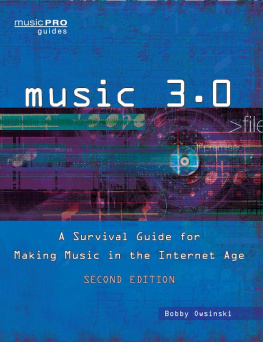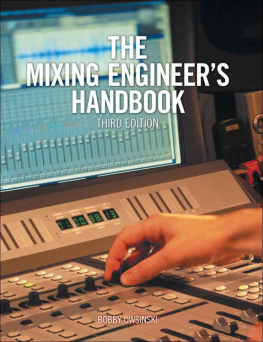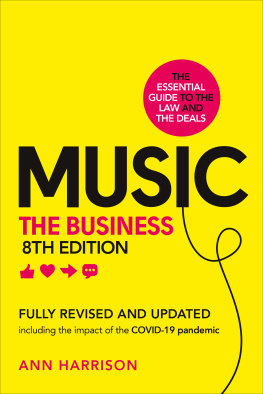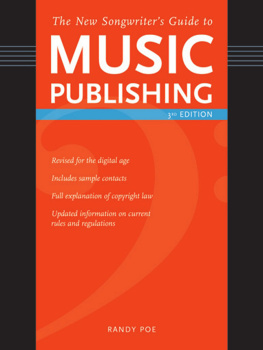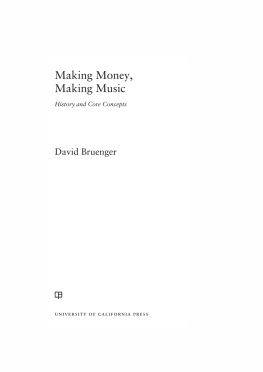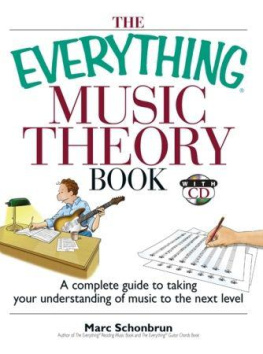
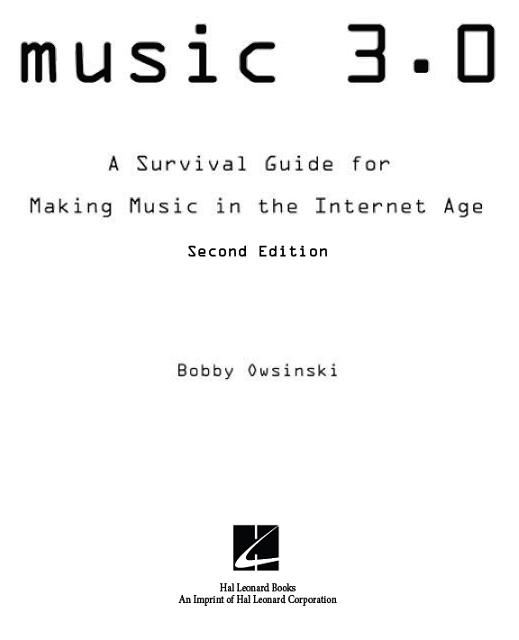
Copyright 2009, 2011 by Bobby Owsinski
All rights reserved. No part of this book may be reproduced in any form, without written permission, except by a newspaper or magazine reviewer who wishes to quote brief passages in connection with a review.
Second edition published in 2011 by
Hal Leonard Books
An Imprint of Hal Leonard Corporation
7777 West Bluemound Road
Milwaukee, WI 53213
Trade Book Division Editorial Offices
33 Plymouth St., Montclair, NJ 07042
First edition published in 2009 by Hal Leonard Books
Library of Congress Cataloging-in-Publication Data
Owsinski, Bobby.
Music 3.0: a survival guide for making music in the new music industry / Bobby Owsinski. 2nd ed.
p. cm.
1. Music tradeTechnological innovations. 2. Music tradeComputer network resources.
3. Music and the Internet. 4. Internet marketing. I. Title.
ML3790.O968 2011
780.688dc23
2011029663
ISBN 9781458429162
www.halleonardbooks.com
Contents
The music world has changed a lot in the two years since I wrote the first edition of this book, but we all knew it would. While we anxiously wait for the music industry to find some point of stability, instead we find it moving ever faster past that point of equilibrium. Which is exactly why this update is so needed.
I originally decided to write this book precisely because the music world was changing so much. Oh, its always been evolving, but the speed of the industrys remodeling has increased at a rate previously unimagined. It would be nice to say that this change is brought about by a leap in musical creativity, but thats not the case. This metamorphosis has been caused by technology.
The Internet has brought us so many conveniences and so many new ways of living our lives, having fun, and communicating with those we know and dont know that we sometimes dont appreciate how quickly its all come about. Its also brought us so many choices in the way we make music and ultimately make it available that, unfortunately, its also left most artists and music makers dazed and confused with all the seemingly endless options. What should I do? How can I do it? Who are my customers and fans? What do they want from me? How do I reach them? How do I take advantage of all these choices? These are all questions that an artist might have had previously, but the relevancy and urgency have only increased with the current times.
I came up with the concept of Music 3.0 after writing a post on my production blog (bobbyowsinski.blogspot.com; theres now also music3point0.blogspot.com) in which I discussed the current woes of not only the music business but especially the artists who are just trying to do the thing they love mostplay music. I know that some artists have grand ambitions to be the next Justin Timberlake, Christina Aguilera, Kanye West, Coldplay, or any number of bestselling acts. Sometimes artists crave fame a lot more than they yearn to make the kind of music that will attract and keep fans for the long term. These musicians seem to be the ones that burn out of the business the fastest, once they realize how much work they really have to put in.
The vast majority of artists arent like that. They love what they do and are supremely happy when they find others that love what they do too. For them, just being able to make music without having to work a job on the side is considered a success. If that describes you, I hear you and feel you. Reading this book might not get you there, but it can set you on your way. Knowledge is powerand that phrase has never been truer than in the current music stage that I call Music 3.0. The possibilities for what can happen to your music are endless, but youve got to know how to take advantage of those possibilities before you can put them into action.
Throughout this book Ill refer to Music 3.0 as M3.0, or M three oh. It has a nice ring and rolls off the tongue well. But youre probably wondering, How did we get to M3.0? What were M1.0, 2.0, and so on? While well go over all that in depth in , heres how I briefly delineate the various stages of the music business.
Music 1.0: The first generation of the music business, in which the product was vinyl records, the artist had no direct contact with the record buyer, radio was the primary source of promotion, the record labels were run by record people, and records were bought from retail stores.
Music 1.5: The second generation of the music business, in which the product was primarily CDs, labels were owned and run by large conglomerates, MTV caused the labels to shift from artist development to image development, radio was still the major source of promotion, and CDs were purchased from retail stores.
Music 2.0: The third generation of the music business, which signaled the beginning of digital music and during which piracy ran rampant due to peer-to-peer networks. The industry, however, took little notice, since CD sales were still strong from radio promotion.
Music 2.5: The fourth generation of the music business, in which digital music became monetized thanks to iTunes and, later, others such as Amazon MP3. CD sales plunged, the music industry contracted, and retail stores closed.
Music 3.0: The current generation of the music business, in which the artist can communicate, interact, market, and sell directly to the fan. Record labels, radio, and television become increasingly irrelevant, and single songs are purchased instead of albums.
This book is an aggregation of concepts about the new music business in the so-called Internet age, which Ive been following for some time. It contains the guiding insights of some of the brightest minds in the music industry about where the industry has been, where it is now, and where its going. With so much information currently available, I wanted to do what I do bestcollect it, organize it, and present it in a way that everyone can understand.
As in my other books, Ive sought out the help of some of the most respected voices that are on the cutting edge of different aspects of the music business, and Ive included their interviews at the end of this book and incorporated selected quotes along the way. The interviews are fun and informative, and conducting them was one of the most enjoyable aspects of writing this book.
Let me briefly introduce these respected industry experts to you:
Ted Cohen: Known throughout the technology and music industries as being part ambassador and part evangelist, Ted has been on the cutting edge of digital music from its inception. Currently a managing partner of the industry consulting firm TAG Strategic, Ted is one of the most influential voices in digital music today and can be heard speaking on the subject worldwide.
Richard Feldman: A very successful songwriter, producer, and Grammy winner, with platinum and Number 1 records to his credit, Richard is the CEO of a music-library publisher called ArtistFirst Music. He comes to publishing from the point of view of a musician and songwriter, and he has a unique perspective on the changes that M3.0 brings.
Larry Gerbrandt: An expert on entertainment analytics, Larrys Media Valuation Partners advises its clients on the economics of media and content on traditional and emerging technology platforms. Formerly a senior vice president with research giant Nielsen Analytics, Larry provides a wealth of experience in entertainment market research that Im pleased we could tap. Get ready for some interesting and insightful facts and figures regarding sponsorships, branding, and advertisingall the things necessary to monetize M3.0.
Next page
